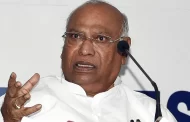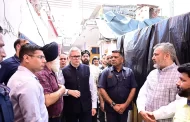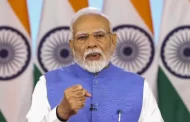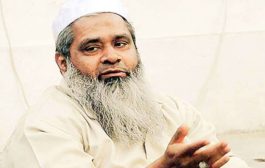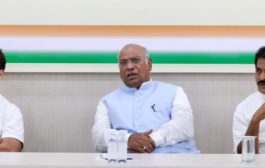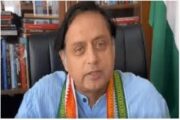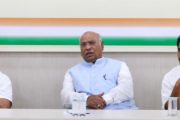Of the 114 foreign visits the Prime Minister has made to over 60 countries since he came to power in 2014, he has visited the US seven times already
Indian Prime Minister Narendra Modi’s 21-24 June visit to the United States at the invitation of President Joe Biden and First Lady Jill Biden is being hailed by both New Delhi and Washington as one that will open up a new era of synergistic relations between the world’s largest democracy and the world’s largest economy.
The two countries cooperate on a wide range of diplomatic, economic and security issues, including defence and joint defence production, non-proliferation, shared democratic values, counterterrorism, climate change, health, energy, education, science and technology, agriculture, space and oceans.
Anticipating the upcoming visit to affirm this deep and close partnership, White House Press Secretary Karine Jean-Pierre noted: “The visit will strengthen our two countries’ shared commitment to a free, open, prosperous and secure Indo-Pacific, and our shared resolve to elevate our strategic technology partnership, including in defence, clean energy, and space.”
India’s Ministry of External Affairs (MEA) said of the two leaders, “They would reflect on their shared vision for a free, open and inclusive Indo-Pacific and discuss opportunities to expand and consolidate the Quad engagement.” The Quad, officially known as Quadrilateral Security Dialogue, was formed in 2006 by the US, India, Australia and Japan as an “informal strategic coalition” against China’s powerplay in the Indo-Pacific.
Of the 114 foreign visits the Prime Minister has made to over 60 countries since he came to power in 2014, he has visited the US seven times already, not having gone so many times to any other country. Yet, this will be his first official state visit to the US, the highest level of diplomatic reception that involves a state dinner on 22 June, his earlier visits having been characterised as official or working visits. The last official state visit by an Indian Prime Minister to the US was undertaken by Manmohan Singh in 2009.
Modi is also scheduled to address a joint session of the US Congress on 22 June, and a gathering of Indian Americans on 23 June ‘on the role of the Indian diaspora in India’s growth story’.
The Prime Minister, however, does not enjoy a fulsome rapport with Democrat Biden as he did with the previous Republican President, Donald Trump, whom he had not only introduced at the “Howdy Modi” rally at Houston’s NRG Stadium in 2019 as “my friend, a friend of India”, but had also cheered for his 2020 re-election bid for the White House by declaring abki baar, Trump sarkar (now, a Trump administration).
Biden’s interactions with Modi seem to convey that his administration lacks a coherent policy on India. At his first meeting with the President at the White House in 2021, Modi was made conscious of the unflattering perceptions within the Biden administration of his government and of his own style of governance that had noted a democratic backsliding in India under his rule.
At the meeting, Biden used diplomatese to paper over what his administration cited was political anarchy taking place in India, while Indian-origin Vice President Kamala Harris did not shirk from telling the Prime Minister in their meeting as to how imperative it was to defend democratic principles and institutions, and to uphold human rights.
Indeed, a coalition of 17 civil rights organisations in the US, including American Muslim Institute, Hindus for Human Rights, Global Christian Relief, American Sikh Council, Genocide Watch, and Human Rights and Grassroots Development Society, wrote to President Biden on 7 June, urging him to reconsider his state dinner invitation to the Prime Minister. “The invitation to Modi as a state guest signals that the US supports India’s crackdown on fundamental democratic rights and emboldens the Modi administration to intensify its anti-democratic agenda,” the letter stated.
“We have and we will continue to strongly urge India to uphold its human rights obligations and commitments,” Acting Assistant Secretary for Democracy, Human Rights, and Labour Erin Barclay said at the release in March of the 2022 Country Reports on Human Rights Practices. The report claimed that India last year experienced significant human rights violations, including unlawful and arbitrary killings, challenges to freedom of press, interference with privacy, and violence targeting religious and ethnic minorities. “The US and India regularly consult at the highest levels on democracy and human rights issues,” said Barclay. “Not surprisingly, we also regularly meet with civil society both in the US and in India to hear their perspectives and learn from their experiences, and we encourage the Government of India to consult with them as well.”
In its 2022 report released ahead of the Prime Ministerial visit, the US State Department’s Office of International Religious Freedom cites numerous reports of violence in India by law enforcement authorities against religious minorities, and indicates, “Attacks on members of religious minority communities, including killings, assaults, and intimidation, occurred in various states throughout the year.”
The ‘2020 Country Reports on Human Rights Practices’ submitted to the US Congress last April stopped just short of accusing the Modi regime of crimes against humanity, when it catalogued a spate of grievous excesses against the Indian public.
While releasing the 2021 edition of the annual report last year, Secretary of State Antony Blinken called India a country where “religious freedom and the rights of religious minorities are under threat”, pointing out that this threat was “due to rising attacks on places of worship”.
India repeatedly refutes these reports, MEA spokesman Arindam Bagchi commenting, “Regrettably, such reports continue to be based on information and flawed understanding.” He added though that while such statements were “motivated”, India still valued its relationship with the US and would continue to have “frank exchanges” on issues surrounding religious freedom.
Indeed, Blinken himself had mentioned in 2021: “The United States and India are working together on so many of the most important challenges of our time and ones that are having a profound impact on the lives of our citizens. The partnership between the United States and India is vital, it’s strong, and it’s increasingly productive.” In his official remarks on the eve of Modi’s visit to the US, John Kirby, Coordinator for Strategic Communications at the National Security Council in the White House, said the US administration never shies from “expressing concerns that we might have with anyone around the world”, adding, “You can do that with friends – you’re supposed to do that with friends.”
Though Modi has projected himself since his 2019 electoral campaign as the only leader who can provide India a strong government and make it a “superpower”, and his supporters have since 2015 been acclaiming him as the vishwaguru, or Teacher to the World, India has been slipping precipitously on most human development parameters under his rule.
The UN Development Programme’s (UNDP’s) Human Development Index 2023 ranks India at 132 out of 191 countries, behind Bangladesh and Sri Lanka, and also estimates that more than 230 million people in India, or 16 per cent of the population of 1.43 billion, still experience poverty, the maximum among all emerging economies, identifying the poor as those living on less than Rs150 (or $1.13) a day.
Biden has centrestaged the defence of democracy across the world, and while visiting Canada in March, had said that his “strategic goal” was to improve relations with the rest of the world as he felt that America’s leverage against China and Russia was through its alliances. “I have now met with 80% of the world leaders just since I’ve been president,” he said.
He considers India – the most populous country and a rising economic power – a key player in the Quad, but desires it to be unequivocal as regards the US-aligned democracies or the autocratic axis led by Russia and China. The President might seek to wrest an unambiguous commitment from the Prime Minister on current geopolitics, as on Russia’s war on Ukraine and China’s rising belligerence, especially when Moscow has raised the ante by announcing the deployment in July of tactical nuclear weapons in Belarus that neighbours Ukraine, and when China has threatened the US. “The US should change its recent mistaken policies towards China, or conflict and confrontation will follow,” Chinese Foreign Minister Qin Gang told a news conference in Beijing in March, viewing as “seriously distorted” Washington’s perception of China as its “primary rival and the most consequential geopolitical challenge”.
Biden has centrestaged the defence of democracy across the world, and while visiting Canada in March, had said that his “strategic goal” was to improve relations with the rest of the world as he felt that America’s leverage against China and Russia was through its alliances. “I have now met with 80% of the world leaders just since I’ve been president,” he said.
He considers India – the most populous country and a rising economic power – a key player in the Quad, but desires it to be unequivocal as regards the US-aligned democracies or the autocratic axis led by Russia and China. The President might seek to wrest an unambiguous commitment from the Prime Minister on current geopolitics, as on Russia’s war on Ukraine and China’s rising belligerence, especially when Moscow has raised the ante by announcing the deployment in July of tactical nuclear weapons in Belarus that neighbours Ukraine, and when China has threatened the US. “The US should change its recent mistaken policies towards China, or conflict and confrontation will follow,” Chinese Foreign Minister Qin Gang told a news conference in Beijing in March, viewing as “seriously distorted” Washington’s perception of China as its “primary rival and the most consequential geopolitical challenge”.
The Modi government considers India an ancient civilisation with expansive influence that is reclaiming its rightful place on the world stage, and believes the country does not need lessons on democratic functioning. It does not accept the Biden administration’s standpoint of a world divided into competing blocs of democracies and autocracies.
In his book, The India Way: Strategies for an Uncertain World, released in 2020, India’s Minister for External Affairs Subrahmanyam Jaishankar observes that the notion of “a universal and invincible globalised order led by the US” was merely “a transient moment of American unipolarity”, and that the idea of an “end of history” was an “arrogant assertion of an era of hubris” based on a “Eurocentric analysis”.
Jaishankar’s view appears to have wider allegiance, going by a recent survey of the US-based business intelligence company, Morning Consult. The survey, covering a thousand respondents in India, shows the US being viewed as the second-most significant security threat to India, after China and ahead of Russia and even Pakistan. While 43 per cent of those polled viewed China as the primary threat, 22 per cent said it was the US, and 13 per cent opted for Pakistan and Russia. “While the world’s two largest democracies would seem to make for natural partners, especially given their mutual mistrust of China, Indians have strategic reasons to be wary of the world’s Western superpower,” said Sonnet Frisbie and Scott Moskowitz who oversaw the survey, reported Bloomberg.
None other than Henry Kissinger, the US Secretary of State of the ‘70s who turned 100 in May, had once said, “To be an enemy of America can be dangerous, but to be a friend is fatal.”
Similarly, many in India within and outside the government resented the March appointment of Biden loyalist and former Los Angeles mayor, Eric Garcetti, as the US ambassador to India. At his confirmation hearings in 2021, Garcetti had said he would “actively raise” human rights issues in India, in response to a question about the Citizenship Amendment Act, which Modi’s Hindu-nationalist Bharatiya Janata Party (BJP) government had legislated in 2019 and which seeks to criminalise Muslim settlers from Afghanistan, Pakistan, and Bangladesh as “illegal migrants”, while allowing other communities from these countries to apply for Indian citizenship. Garcetti maintained he would “engage directly with civil society”, pointing out, “There are groups that are actively fighting for human rights…they will get direct engagement from me.”
Soon after his arrival in New Delhi, the US embassy launched a programme for “teaching” Indian youths to “think critically”. The embassy was partnered by Ford Foundation and IREX (International Research & Exchanges Board), a nonprofit organisation for global education and development that is supported by George Soros. The billionaire financier, philanthropist and activist is known for his strong views on Prime Minister Modi and his government, and was once publicly dismissed by External Affairs Minister Jaishankar as “old, rich, opinionated and dangerous”.
In February, during a speech ahead of the Munich Security Conference, Soros said: “India is an interesting case. It’s a democracy, but its leader, Narendra Modi, is no democrat. Inciting violence against Muslims was an important factor in his meteoric rise. Modi maintains close relations with both open and closed societies. India is a member of the Quad, which includes Australia, the US and Japan, but it buys a lot of Russian oil at a steep discount and makes a lot of money out of it.”
Ex-BJP MP Tarun Vijay tweeted that sending an ambassador “with a political agenda to interfere in our domestic issues with false notions” is “ignorant and arrogant” and “must not be acceptable”. And Abhinav Prakash, vice president of BJP’s youth wing, told Russian state-owned news agency Sputnik India that Garcetti’s appointment could fuel “anti-West sentiment” in India.
India has resisted Western pressure to freeze out Moscow, and has instead strengthened its trade ties with its long-standing ally, from which it secures discounted crude. According to the International Energy Agency, India imported 1.96 million barrels a day from Russia in May, 15 per cent more than the previous high in April and almost half its total oil imports, up from just one per cent of inflows from Russia before the latter attacked Ukraine in February last year. India has consequently become the key oil supplier to Europe to which it sells the crude after refining it.
While Biden is also perhaps mindful of the fact that Modi has been unable to raise with Chinese President Xi Jinping the issue of thousands of People’s Liberation Army (PLA) troops yet occupying several border areas after they overran India’s border Union Territory of Ladakh in May 2020. The Modi regime seems to lack a coherent strategy against Chinese belligerence, as it also appears unable to counter further Chinese cross-border transgressions in India’s other border states of Arunachal Pradesh, Uttarakhand and Sikkim.
In March 2022, then US Ambassador to India Kenneth Juster had said that New Delhi did not want Washington to mention China’s border aggression in any joint statements. “The restraint in mentioning China in any US-India communication or any Quad communication comes from India, which is very concerned about not poking China in the eye,” he had mentioned.
New Delhi’s stance is compelled by realism as it is circumspect about China’s vaulting ambitions, as also about the crosshairs of conflicting interests in this region of immense geostrategic import. It does not desire to be seen as too partisan and it certainly does not desire the situation to precipitate into war. It has, however, been led by the China factor to increasingly pivot its defence spending to Washington under the India-US Strategic Partnership Agreement of 2004, as it craves the indulgence of America to support, and validate, its aspirations for great power status.
It was then US President Barack Obama who had revoked US sanctions against Modi once he became Prime Minister in 2014. Modi had been denied a visa to enter the US in 2005, when he was Chief Minister of Gujarat, under the US’s Immigration and Nationality Act that “makes any government official who was responsible for or directly carried out at any time particularly severe violations of religious freedom ineligible for a visa”. The then George W. Bush administration had determined that Modi had failed to check the Hindu-Muslim riots in his homestate in 2002, though an Indian Supreme Court-appointed panel had found no such evidence.
It was nevertheless Bush’s signing of the strategic partnership agreement in 2004 with then Prime Minister Atal Bihari Vajpayee that had been the turning point in India-US relations where both the countries approved expanding cooperation in the three specific areas of civilian nuclear energy, civilian space programmes, and high-technology trade, apart from missile defence. This, in turn, led to the signing in Washington the following year of the landmark accord on civilian nuclear energy by Bush and Vajpayee’s successor Manmohan Singh, which reversed three decades of American non-proliferation policy.
The nuclear deal was eventually ‘operationalised’ in a 2015 meeting with Prime Minister Modi by President Obama during his three-day state visit to India, elevating the bilateral partnership to a new dimension.
US-India defense cooperation has also reached new heights, including through information sharing, liaison officers, increasingly complex exercises like Malabar, and defense enabling agreements, such as the secure communications agreement COMCASA. India conducts more military exercises with the US than with any other country, and as of 2020, Washington has authorised over $20 billion in defence sales to India.
The first American President to have visited India twice during his tenure, Obama had written in New York Times in 2010 how critical India’s economic power was to the US. “In fact, every $1 billion we export supports more than 5,000 jobs at home,” he wrote.
Source: NH


